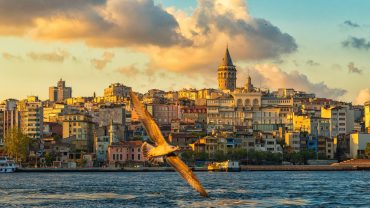Erzincan (pronounced [æɾˈzindcan]) is the capital of Erzincan Province in Eastern Turkey. Nearby cities include Erzurum, Sivas, Tunceli, Bingöl, Elâzığ, Malatya, Gümüşhane, Bayburt, and Giresun. The city is majority Sunni Turkish with a significant Alevi Kurdish minority.
The city is notable for handcrafted copper goods and a special cheese called “tulum peyniri” in Turkish. It is a significant road and rail junction and was once noted for its silverware. Current industries include sugar refining and textile industries. The city is home to the headquarters of the Third Army.
History
Acilisene, the ancient city that is now Erzincan, was the site of the Peace of Acilisene by which in AD 387 Armenia was divided into two vassal states, a smaller one dependent on the Byzantine Empire and a larger one dependent on Persia. This is the name (Ἀκιλισηνή in Greek) by which it is called by Strabo in his Geography, 11.4.14. The etymological origin of the word is disputed, but it is agreed that the city was once called Erez. For a while it was called Justinianopolis in honour of Emperor Justinian. In more recent Greek it has been called as Κελτζηνή (Keltzene) and Κελεζηνή (Kelezene)
In the Armenian language, the 5th-century Life of Mashtots called it Yekeghiats In the more recent past, it was known in Armenian as Երզնկա (Yerznka)
In the settlement of Erez, at a yet unidentified site, there was a pre-Christian shrine dedicated to the Armenian goddess Anahit. A text of Agathangelos reports that during the first year of his reign, King Trdat of Armenia went to Erez and visited Anahit’s temple to offer sacrifice. He ordered Gregory the Illuminator, who was secretly a Christian, to make an offering at its altar. When Gregory refused, he was taken captive and tortured, starting the events that would end with Trdat’s conversion to Christianity some 14 years later. After that conversion, during the Christianisation of Armenia, the temple at Erez was destroyed and its property and lands were given to Gregory. It later became known for its extensive monasteries.
It is hard to tell when Acilisene became a bishopric. The first whose name is known is of the mid-5th century: Ioannes, who in 459 signed the decree of Patriarch Gennadius I of Constantinople against the simoniacs. Georgius or Gregorius (both forms are found) was one of the Fathers of the Second Council of Constantinople (553), appearing as “bishop of Justinianopolis”. Theodorus was at the Third Council of Constantinople in 681, signing as “bishop of Justinianopolis or the region of Ecclenzine”. Georgius was at the Photian Council of Constantinople (879). Until the 10th century, the diocese itself appears in none of the Notitiae Episcopatuum. At the end of that century, they present it as an autocephalous archdiocese, and those of the 11th century present it as a metropolitan see with 21 suffragans. This was the time of greatest splendour of Acilisene, which ended with the decisive defeat of the Byzantines by the Seljuq Turks at the Battle of Manzikert in 1071. After the 13th century, there is no mention of diocesan bishops of Acilisene and the see no longer appears in Notitiae Episcopatuum. No longer a residential bishopric, Acilisene is today listed by the Catholic Church as a titular see.
In 1071 Erzincan was absorbed into the Mengüçoğlu under the Seljuk Sulëiman Kutalmish. Marco Polo, who wrote about his visit to Erzincan, said that the “people of the country are Armenians” and that Erzincan was the “noblest of cities” which contained the See of an Archbishop. In 1243 it was destroyed in fighting between the Seljuks under Kaykhusraw II and the Mongols. However, by 1254 its population had recovered enough that William of Rubruck was able to say an earthquake had killed more than 10,000 people. During this period, the city reached a level of semi-independence under the rule of Armenian princes.
Erzincan was one of the most pivotal towns in Safavid history. It was there, in the summer of 1500, that about 7,000 Qizilbash forces, consisting of the Ustaclu, Shamlu, Rumlu, Tekelu, Zhulkadir, Afshar, Qajar and Varsak tribes, responded to the invitation of Ismail I, who would aid in him establishing his dynasty.
Battle of Erzincan
The Battle of Erzincan took place during the Caucasus Campaign of the First World War. In 1916 Erzincan was the headquarters for the Turkish Third Army commanded by Kerim Pasha. The Russian General Nikolai Yudenich led the Russian Caucasus Army who captured Mama Hatun on 12 July 1916. They then gained the heights of Naglika and took a Turkish position on the banks of the Durum Durasi river, with their cavalry breaking through the Boz-Tapa-Meretkli line. They then advanced on Erzincan arriving by 25 June and taking the city in two days. The city was relatively untouched by battle and Yudenich seized large quantities of supplies. Despite the strategic advantages gained from this victory, Yudenich made no more significant advances and his forces were reduced due to Russian reverses further north.
Colonel Kâzım Karabekir was appointed the commander of the First Caucasian Army Corps. Aware of the withdrawal of the Russian Army following the Russian Revolution, they retook Erzincan in February 1918.
Erzincan Soviet
A short-lived soviet council had been at Erzincan between 1916 and 1921. Mainly today’s Erzincan and Tunceli provinces were under Russian occupation. After the revolution, Bolshevik soldiers took control of the officer corps. Arşak Cemalyan who was a Bolshevik soldier, called Kurdish, Turkish and Armenian representatives to take charge of the administration of Erzincan Soviet.
Climate
Erzincan has a continental climate (Köppen climate classification Dsa) with freezing, snowy winters and hot and dry summers. Spring is the wettest season whilst late summer is the driest. The lowest temperature recorded was −32.5 °C (−26.5 °F) in January 1950. The highest temperature recorded was 40.6 °C (105.1 °F) in July 2000. The highest snow thickness recorded was 74 cm (29.1 inches) in February 1950.
Transportation
Erzincan is provided by air and road transportation. Besides the big cities such as Istanbul Turkey, Ankara Turkey, Izmir Turkey, Antalya Turkey and Bursa Turkey, there are regular bus companies from all provinces. Those who want to travel by air can use Erzincan Airport. The airport is just 7 km from the city center. When you need Erzincan Airport Transfers, you can support car rental from our site.
Traveling Places in Erzincan, Turkey
Dark Canyon
Located in the town of Kemaliye in Erzincan, the canyon attracts great attention with its impressive natural beauties. Karanlık Canyon, home to various nature sports, is among the largest canyons in the world. It is one of the travel points we recommend going to Erzincan, Turkey.
Erzincan Spa
Providing a source of healing for various diseases, the region is one of the important places in health tourism. The sources of Erzincan Ilıcası, which are useful for skin, heart, rheumatism and vascular diseases, are known with the installations made in this regard and they are an example to the natural beauties of Erzincan, Turkey.
Kadıgol
Kadıgol, located in Kemaliye; Erzincan is one of the most popular destinations with its natural beauties, peaceful weather and many trout breeding facilities.
Stallions Lake
Lake camping and rock landing in this stallion is one of Turkey’s largest crater lake, also boating and hiking. Aygır Lake, one of the best examples of natural beauties of Erzincan, should be at the top of your list of places to visit in Erzincan.
Mama Hatun Caravanserai
It is one of the largest architectural monuments of the city of Erzincan Mama Hatun Caravanserai. The Mama Hatun Caravanserai, which was carefully built with yellow cut stone, witnesses the history of Erzincan since the 12th century. It can be written among the historical sites of Erzincan, Turkey.
Melik Gazi Tomb
The tomb in Kemah district belongs to Melik Gazi, the founding leader of the Mengücek Principality. Melik Gazi Tomb, which is one of the most visited places of the region, is one of the important historical places of Erzincan, Turkey.
Hidir Abdal Sultan Tomb
It is one of the most important points of the city. Hıdır Abdal Sultan, who is a great saint, is known as the person who took the banner of the Anatolian Islamic traditions after Hacı Bektaşi Veli.
Bolkar Siki Center
Although it is not known as Palandöken Ski Center in Erzurum province, it is one of the important winter holiday locations of Erzincan. Bolkar Ski Center, which is 40 km away from the center of Erzincan, is an indispensable address for nature lovers during the summer breaks and summer holidays. We recommend you to put the Bolkar Mountains and Bolkar Ski Center, one of the natural beauties of Erzincan, into your Erzincan list of places to visit.
Sakaltutan Ski Center
It is the shining star of Erzincan in winter tourism. The ski resort, where the installations are rapidly increasing, will be remarkable with its ideal runways and will soon be demanded for Winter Tourism such as Palandoken Ski Center, Uludag Ski Center and Erciyes Ski Center.
Girlevik Waterfall
If you are looking for a stop to rest your soul, you should definitely see Girlevik Falls. Erzincan is the beauty of Erzincan, which is waiting to be explored with its natural beauties and wide excursion paths, which include hundreds of different plant species.





Comment (0)